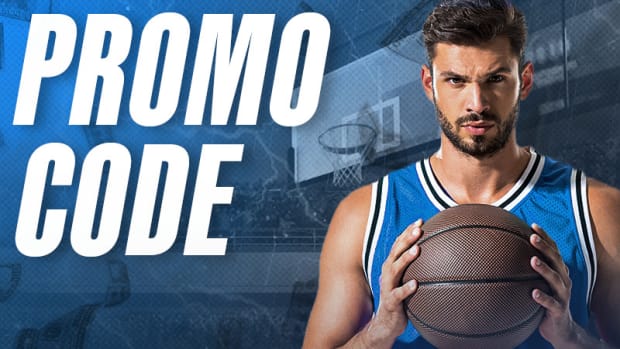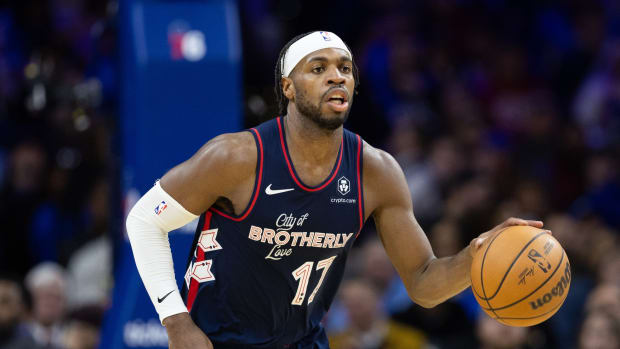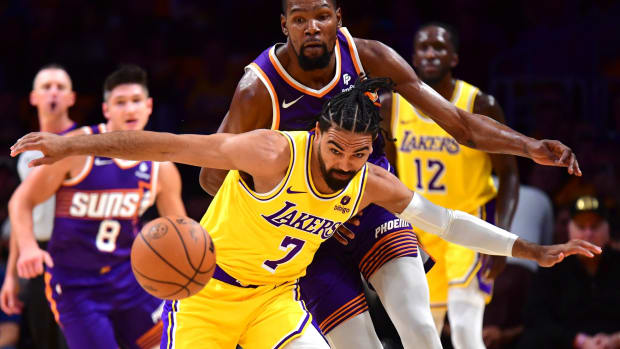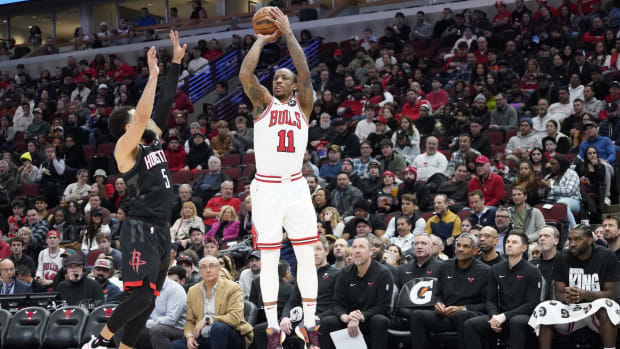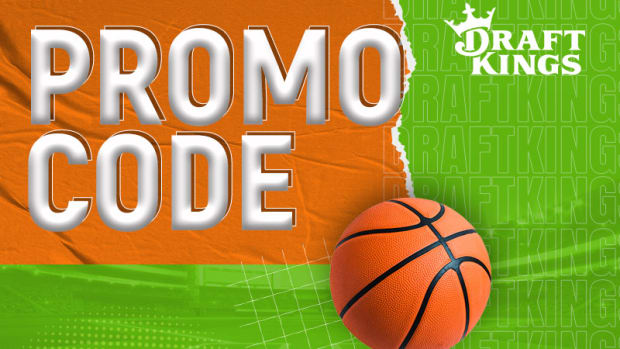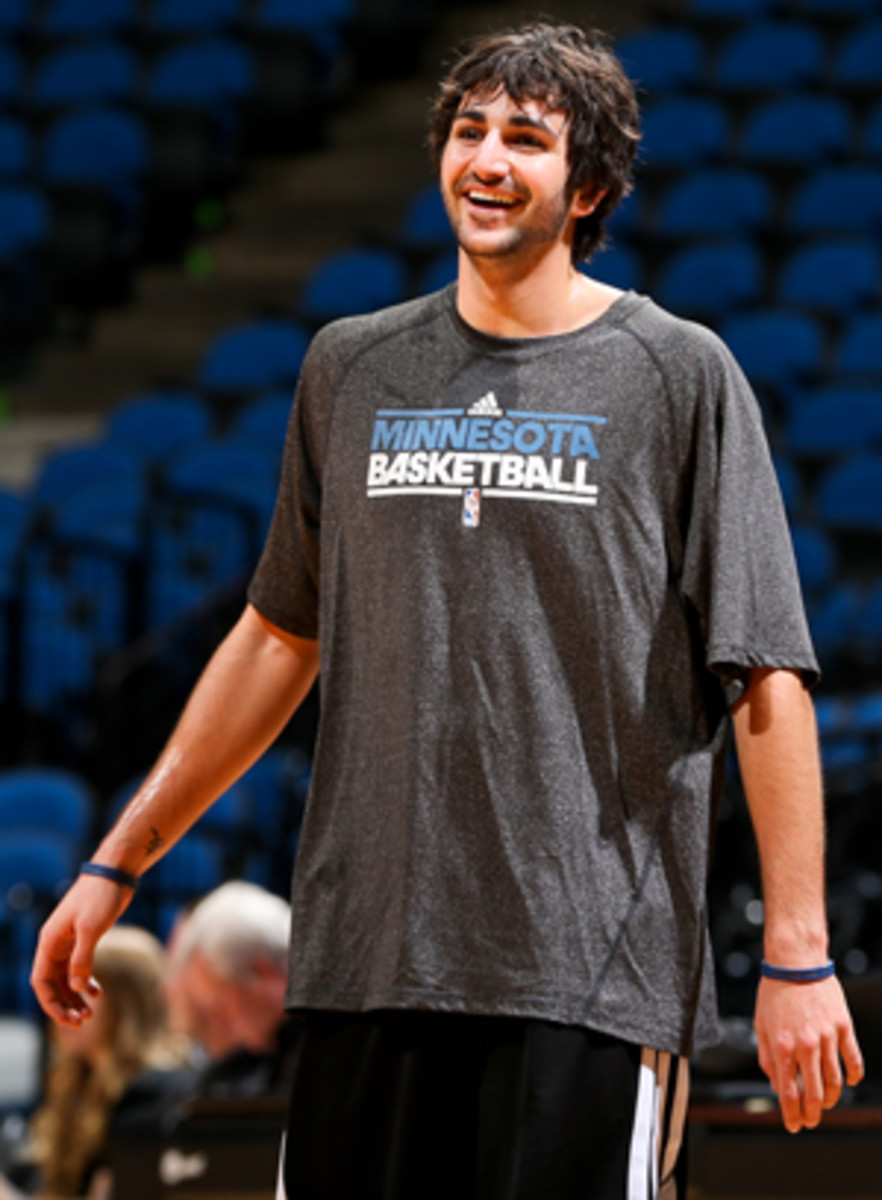
The Fundamentals: After slow start, Ricky Rubio looks more like his old self
Ricky Rubio has played more aggressively lately as he seeks to regain his rookie form. (Jim Mone/AP)
By Rob Mahoney
Players who capture the NBA world's imagination have the misfortune of bearing the highest of public hopes, and it was under that burden that Ricky Rubio's season seemed buried.
The point guard's return from the ACL tear that he sustained in March was highly anticipated after his exhilarating rookie season. That the injury-plagued Timberwolves badly needed the spark he provided as a first-year player and the promise that his very presence might provide only added to the expectations.
But when Rubio finally did make his season debut on Dec. 15, he looked to be a completely different player. Some rust was to be expected after nine months without game action, but as the weeks wore on, Rubio only seemed to grow more tentative. The charms of his game were unsettled by worry and likely by lingering soreness, and the Wolves did their best to compete alongside a poor imitation of their franchise-changing floor leader.
For 19 games, Rubio averaged 8.4 points (on 31 percent shooting from the field), 8.2 assists and 3.8 turnovers per 36 minutes -- numbers that don't adequately convey the uninspired quality of his play or his clear detriment to his team's performance. Once a wizard with the ball, Rubio now looked to be uncomfortable when put in control of the offense. He deferred to backcourt mates Luke Ridnour and Alexey Shved far more frequently than one might expect, even as he logged more games and more minutes as his comeback progressed. The sight of an anxious Rubio was almost distressing, as it betrayed the exuberant style of play that is so central to his basketball identity.
Rather quickly, hope withered into tolerance, which decayed into concern. Many wondered how a player who seemed to have physically recovered from his surgery could be so fundamentally different from the one who made the Wolves playoff hopefuls a season ago. It wasn't just Rubio's production that had vanished, after all, but the joie de vivre that made his game so audacious and effective. Rubio was struggling and he knew it, and his spiraling frustrations left him as one of the least effective lead guards in the league. Things indeed grew that dire, until the quality of his play changed suddenly.
I couldn't tell you what happened to Rubio on Feb. 3 (a cosmic event? A particularly focused meditation session? An especially fulfilling meal?), but after that off-day he reverted to wonderfully spirited form. Yes, Rubio had shown glimpses of his full game on rare occasions, but it was in a 100-98 loss to the Trail Blazers on Feb. 4 that the Spaniard finally rediscovered his basketball self. He finished with 15 points and 14 assists, and the 22-year-old hasn't looked back since. In the last nine games, Rubio has averaged 15 points, 9.9 assists, 3.8 turnovers and 3.2 steals per 36 minutes while playing far more aggressively with the ball.
The fact that his scoring has jumped so significantly isn't a coincidence of hot shooting, but a product of Rubio's will. The tentativeness that defined his first 19 games is mostly absent of late, as Rubio has consistently made it a point to probe and attack defenses off the dribble. That's quite an adjustment for a player whose lack of confidence around the rim has occasionally deterred him from driving, but the payoff has been profound. Here are a series of half-court plays showing Rubio's assertiveness in getting into the paint and drawing fouls:
He's also made a concerted effort to seek out contact in the open court, particularly when his teammates aren't in a position to score or the opponent plays him to pass:
As a result, Rubio has averaged 8.2 free-throw attempts per 36 minutes over that nine-game stretch -- a mark that rivals the season averages of Kevin Durant and James Harden. What makes this aggressive streak especially beneficial is that the Wolves already draw fouls effectively as a team, making even the non-shooting fouls that Rubio is able to draw valuable in building toward the penalty. Add in the shots that Rubio creates for his teammates by penetrating more, and his comprehensive offensive effect begins to take shape again. That strain of Rubio's performance may be a bit exaggerated relative to his rookie-year play, but it nevertheless allows him to take advantage of his handle, passing and ability to find openings in the defense in familiar ways. Ricky's back, and he has the game at his fingertips once again:
And just as important, Rubio's defensive timing seems to have improved rather dramatically over the last handful of games. Rubio's defensive play a year ago was one of the NBA's best-kept secrets, though his skills on that end understandably didn't hold up well after missing so much time. He still has a ways to go in terms of finding that perfect chemistry with an overhauled Wolves team, but it's reassuring to see him clogging the right passing lanes and making controlled gambles again after a few weeks of missing his marks. He's not the quickest or the strongest guard, but Rubio has fantastic hands and an innate sense of how to impede the offense without abandoning his man. He has a knack for sliding over just enough to create a deflection or cause a shooter to hesitate, and though those instincts were still present throughout his struggles, his execution was unsure.
No longer. Rubio's resurrected confidence has bolstered his entire game, though now the Wolves are learning to work alongside a player with whom they're not quite familiar. It'll take some time, and isn't likely to pay off quickly enough for 12th-place Minnesota to return to the Western Conference playoff race. That's a shame given all that the Wolves have endured this season, though I suspect they'll settle for getting all of their core pieces healthy for a new season and seeing an animated Rubio in full command of his game once again.
Pacers power forward Tyler Hansbrough is one of the NBA's best at drawing fouls. (Darron Cummings/AP)
GO FIGURE
• Tyler Hansbrough's knack for seeking out contact is well-known, but it's still a bit surprising to see him rank second in the NBA in average fouls drawn per 36 minutes with 7.2. The Pacers' forward joins a top six that includes expected headliners Dwight Howard, Kevin Durant and James Harden.
• Chris Andersen, who is 14 games into his stint with the Heat, has been valuable in creating chaos and getting out into the open court. He's so reliant on opponents' breakdowns, in fact, that a whopping 50 percent of Andersen's points have come as a result of the opposing team's turnover.
• Thaddeus Young returned to the Sixers' lineup Sunday, just in time for Philadelphia to lose its fifth consecutive game. Still, that's big news for a team in the midst of a tough stretch. Young is such a constructive influence for the Sixers, who didn't have anyone who could really replicate his impact during his six-game absence. Young is the rare big man who is mobile and flexible in dealing with opposing threats. Plus, Young's 14.9 points shouldn't be overlooked, especially considering that he averages an impressive 10.9 points in the paint per 36 minutes (in the ballpark of LeBron James, Blake Griffin and Dwight Howard) for a team that ranks 25th in scoring in the lane.
NOTES FROM AROUND THE ASSOCIATION
1. David Lee on the roll
Lee's lack of traditional athleticism casts him far from the pick-and-roll ideal, but I continue to be amazed by the diversity of his finishes as a roll man and the variety in his execution:
Far too many big men tend to roll in one way and at one speed, but with Lee it's almost impossible to predict whether he's intending to streak hard to the rim, float out to the perimeter for a jumper or milk a delayed roll to dive into open space. He effectively makes the Warriors' two-man game a dual-read set. Not only do patient guards like Stephen Curry and Jarrett Jack have their options to attack or defer, but Lee also makes his own read on the spacing of the floor and the timing of his cut.
2. The solidarity of Dahntay Jones
Jones was among the Mavericks players who pledged to grow out their beards until Dallas got back to .500, and he's lived up to his word so far. The remarkable part of that: He isn't even on the Mavericks' roster anymore. Dallas shipped Jones to Atlanta for Anthony Morrow at the trade deadline, but Jones reportedly still intends to boycott his razor until his now-former teammates rally to a break-even record. (Dallas is 25-30 after Sunday's loss to the Lakers.) Pretty awesome display of solidarity from a player who was in Dallas for only a half season.
3. Glimpsing the Clippers' full rotation
Injuries have kept the Clippers from being at full strength for much of this season, but coach Vinny Del Negro's roster is nearing completion as a handful of players work their way back into game shape. As a result, we're starting to see how one of the deepest teams in the league might be managed when all of its resources are available -- and whose minutes might be squeezed. A few thoughts on the subject:
• Grant Hill may wind up being the most selectively used player on the roster, as the success of Jamal Crawford and Matt Barnes leaves precious few minutes for Hill as a reserve wing. That said, when the Clips can afford to go small -- as they did against the second units of the Spurs and Lakers -- expect to see Hill shift up to the 4 to complete the all-bench lineup in place of Ryan Hollins.
• Guard Willie Green is a perfectly decent player to have around, but I'm relieved to see that Del Negro isn't making an effort to find opportunities for him in the rotation. There just isn't any room for him with Chauncey Billups back in the mix, and it would be a shame if some worthier player saw their minutes cut on Green's behalf.
• Despite the various shakeups, the Clippers seem committed to keeping their platoon-style second unit intact. That's a victory for both the team and fans. That group has provided a highly entertaining change of pace and given L.A. an explosive element to work with beyond its high-functioning starting five.
4. MarShon Brooks: A one-act, one-man play
I'm not sure there is a more MarShon Brooks play than this. Even his passes to himself are really shot attempts.
5. A rare breed
The NBA has an incredible ensemble cast laced with idiosyncrasies, as talented players combine disparate skills in ways that are unique to their games. One such example: New Orleans' Ryan Anderson, a high-volume, highly accurate three-point shooter who also happens to rate as a rather impressive offensive rebounder.
On a very basic level, the coexistence of those attributes seems rather impossible. The league's best shooters spend a lot of time outside the three-point arc, far away from the opportunities for boards that come from standing deep in the paint. But Anderson makes an impact on the offensive glass through effort alone, often sprinting in from the perimeter to contest for a potential rebound. That action incredibly difficult for a defense to counter -- try boxing out a 6-10 forward diving to the rim.
The bottom line: Anderson averages an NBA-high 7.2 three-point attempts and grabs a greater percentage of available offensive rebounds than Blake Griffin, Marc Gasol, Al Horford or Tim Duncan. The only other player to even approach that kind of joint statistical success: Kevin Love.
6. The slightest cause for concern
I don't know that it's a glaring enough problem to really justify hand-wringing at this point, but Oklahoma City coach Scott Brooks ought to be a little concerned about the Thunder's late-game offense. Things have clammed up for OKC in the fourth quarter at various points throughout this season, making the league's most prolific offense look oddly solvable. It's going to be tough enough for any opponent to beat the Thunder in a seven-game series regardless, but I think it's worth wondering if the final stretch of close games is where the trade-off between James Harden and Kevin Martin hurts OKC the most.
7. Dwight Howard's visible disinterest
The disconnect between Lakers coach Mike D'Antoni and his center is palpable on most every Howard screen. Watch closely the next time Howard reluctantly trots up from the block to set a pick for Kobe Bryant. Even if Howard's preference to work from the post weren't publicly known at this point, one could read his body language and technique to easily discern his disinterest. On many occasions, Howard rolls through the motions so quickly that he barely even makes contact, leaving the ball-handler to face a hard trap with the screen as a vehicle. Such a shame, given that Howard was so successful as a committed screen-and-roll player in Orlando before a change of taste and several injuries shifted his attentions.
8. Tempting Norris Cole
Opponents have so little reason to pay mind to Heat backup point guard Norris Cole at this stage in his career. At the outset of his rookie season last year, Cole looked to be a decent asset for a team with unpredictable guard play. As useful as Mario Chalmers is on some nights, his zero-sum game typically offsets his big shots and good reads with head-scratching errors. Cole was seen as an immediately viable alternative, quick enough to work off the bounce and confident enough to spot up effectively.
That hasn't quite panned out, as Cole's long-range shooting has fallen off (he's made 14 in 55 attempts this season, for 25.5 percent) and his creation off the dribble is at best rather unintimidating. Opponents would strongly prefer that Cole control a possession rather than give up the ball to LeBron James, Dwyane Wade, Chris Bosh or any number of accurate three-point shooters, and thus the defense often skews to give Cole certain opportunities. Clever on-ball defenders relax to give him a driving lane into help. Others offer a cushion for him to fire a pull-up jumper. Cole doesn't always bite, but look for defenses to continue to exploit this tactic.
Statistical support for this post provided by NBA.com.
































